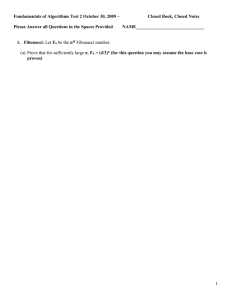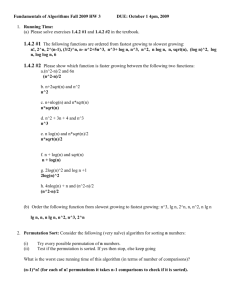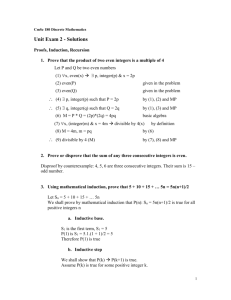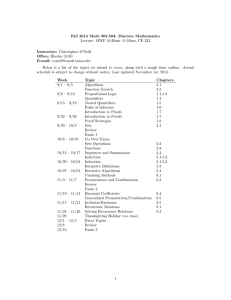Fundamentals of Algorithms Midterm Examination October 16, 2009 – Closed... Please Answer all Questions in the Spaces Provided
advertisement
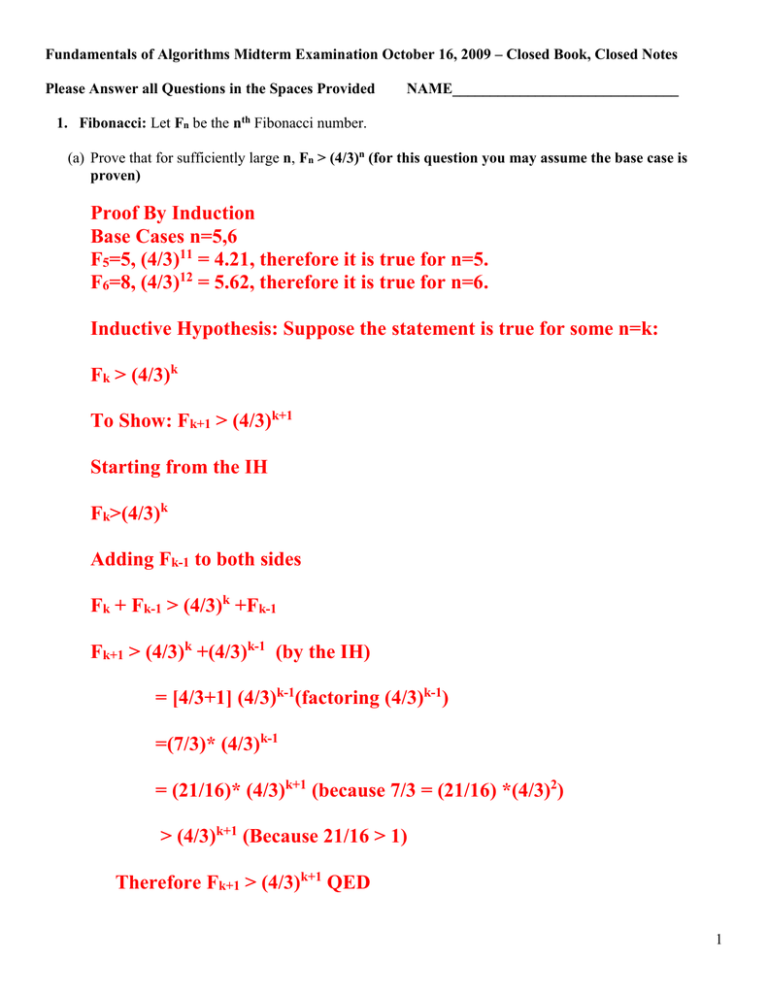
Fundamentals of Algorithms Midterm Examination October 16, 2009 – Closed Book, Closed Notes Please Answer all Questions in the Spaces Provided NAME______________________________ 1. Fibonacci: Let Fn be the nth Fibonacci number. (a) Prove that for sufficiently large n, Fn > (4/3)n (for this question you may assume the base case is proven) Proof By Induction Base Cases n=5,6 F5=5, (4/3)11 = 4.21, therefore it is true for n=5. F6=8, (4/3)12 = 5.62, therefore it is true for n=6. Inductive Hypothesis: Suppose the statement is true for some n=k: Fk > (4/3)k To Show: Fk+1 > (4/3)k+1 Starting from the IH Fk>(4/3)k Adding Fk-1 to both sides Fk + Fk-1 > (4/3)k +Fk-1 Fk+1 > (4/3)k +(4/3)k-1 (by the IH) = [4/3+1] (4/3)k-1(factoring (4/3)k-1) =(7/3)* (4/3)k-1 = (21/16)* (4/3)k+1 (because 7/3 = (21/16) *(4/3)2) > (4/3)k+1 (Because 21/16 > 1) Therefore Fk+1 > (4/3)k+1 QED 1 (b) Prove that Fn < 3n. Proof By Induction Base case n=0 F_0 = 0, 30 = 1, there the statement is true for n=1. IH: Fk < 3k TS: Fk+1 < 3k+1 Taking the left hand side of TS: Fk+1 = Fk + Fk-1 < 3k + 3k-1 (by the IH) = 3k-1[3+1] (factoring 3k-1) = 4*3k-1 < 9*3k-1 = 3k+1 Therefore Fk+1 < 2k+1 QED 2 2. Give a complete analysis of the running time of Merge Sort and prove that it takes O (nlgn) comparisons (you may assume n=2k to simplify the analysis). Hint: (1) State the appropriate recurrence equation (2) Guess the closed form solution (3) Prove the closed form solution you guessed in (2) by induction. The most straightforward approach is to state a recurrence equation and then solve it. For a list of size n, merge sort will divide the list in two, recursively sort each half and then merge the two lists. For simplicity we will say we can do the merging with n comparisons. Then the number of comparison for sorting a list of size n can be stated as T(n) = 2T(n/2)+n. Also to simplify things a bit we will state our base case as T(2)=2 (as opposed to the more natural T(2)=1). So now we just have to solve the recurrence T(n)=2T(n/2)+n, T(2)=2 We can fairly easily solve this by plugging in values and guessing the pattern. T(2)=2 = 2*1 T(4)=8 = 4*2 T(8)=24=8*3 T(16)=64 = 16*4 T(32)=160=32*5 It is easy to verify that T(n) = nlg n satisfies this recurrence. This can be verified by induction. Setting n=2k for simplicity: Base case: T(2)=2 IH: T(2k) = (2k)*k TS: T(2k+1)=(2k+1)(k+1) Taking the left hand side of TS: 3 T(2k+1) = 2T(2k)+ 2k+1 (plugging into the recurrence) = 2k2k +2k+1 (using the IH) = k*2k+1+ 2k+1 = 2k+1 (k+1) QED 4 3. Give a complete analysis of the running time of Karatsuba’s algorithm and prove that it uses O (nlg3) multiplications of single digits (you may assume n=2k to simplify the analysis). Hint: (1) State the appropriate recurrence equation (2) Guess the closed form solution (3) Prove the closed form solution you guessed in (2) by induction. Karatsuba’s algorithm works by splitting the two numbers to be multiplied into two halves each and then multiplying those halves using 3 multiplications (by reusing one of the multiplications). Hence stated as a recurrence the number of multiplications T(n) is T(n) = 3T(n/2), T(1)=1 As before we can plug in values and guess T(1)=1 T(2)=3 T(4)=9 T(8)=27 T(16)=81 It is easy to see that the pattern is T(2k)= 3k Now 3k = (2lg 3)k=(2k)lg 3 If we set n=2k then we have T(n)= nlg 3 Again we can verify this by induction. Base case T(1)=1 IH: T(2k) =3k TS:T(2k+1)= 3k+1 Taking the left hand side of TS: T(2k+1) = 3(T(2k)) (using the recurrence equation) = 3(3k) (by the IH) = 3k+1 QED 5 4. Show that sorting an array of n numbers will take Ω (nlgn) comparisons. Hint: Use the decision tree model. The following facts may be helpful to you: Fact 1: There are n! permutations of n objects. Fact 2: A tree with L leaves must have height at least ┌log L┐. Fact 3: (n/2) n/2 < n! (1) There are n! permutations of n numbers, hence any decision tree will have to have at least n! leaves to account for all the possible results of sorting n numbers. (2) We use Fact 2 that a binary tree with L leaves must have height at least lg L┐ In this case L=n! so the tree must have height ┌lg n!┐ ┌ (3) We use Fact 3 that n! > (n/2)(n/2) Taking logs of both sides we then have lg(n!) > (n/2)lg(n/2) = Ω (nlgn) So the height of the decision tree must be at least Ω (nlgn) and any comparison algorithm will require at least Ω (nlgn) comparisons QED. 6 5. RSA Suppose your public key is n=15, e=3 and your private key is n=15, d=3. Someone sends you the ciphertext c=7. What is the corresponding plaintext m? RSA Decryption m=cd mod n = 73 mod 15 = 13 7
